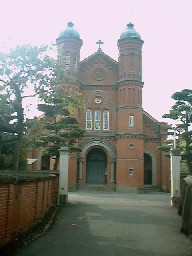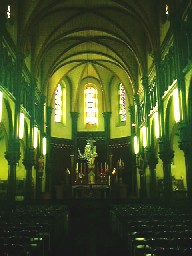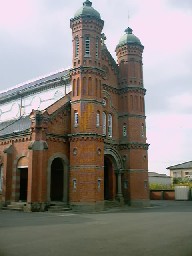Imamura Christianity Church
There is a village in extensive Chikugo plain where has continued protecting Christianity faith,enduring the distress and the suppression.
It is Imamura village in Tachiarai.
The symbol of Imamura village is the Catholic Church that kept bearing a historical snowstorm.
Chikugo province was the land where Christianity faith had been strong since the earlier times.
Since F. Xavier had introduced Christianity in 1549, many Daimyos(feudal lords) of Kyushu have protected Christianity.
Toshisige Mouri of the Kurume feudal lord, and his wife were passionate believer.
IRUMAN (propagation teacher) visited Kurume in 1600, and gave 700 persons the baptism.
Since the Mouri Family protected and encouraged the believers to make Chikugo a Christian's Heaven, the believer of Chikugo was said to amount to 7000 persons at peak.
However, Hidekane Mouri was defeated in the Battle of Sekigahara, and the Christian of Chikugo lost the guardian.and the number of believers had decreased.
However, Christians continued protecting faith under the instruction of the missionaries who had still remained in Hakata.
Although Yoshimasa Tanaka who was granted to reign Chikugo province with 320,000 goku took care of Christians after the Battle of Sekigahara, the storm of suppression had blown violently also on this land since the anti-Christian edicts that Hideyoshi Toyotomi had issued in Hakata in 1587.
Especially the storm of the suppression based on nationwide anti-Christian edicts issued by Ieyasu Tokugawa in 1614 begun ,and blew violently also on this province just after the Shimabara Uprising in 1638.

Imamura Catholic Church
|

The chapel of
Imamura Catholic Church
|

Imamura Catholic Church
|
Although this Imamura's believers were not certain about how they rooted in this ground, it is told it was the beginning that the believers who suffered the suppression in the Shimabara Uprising (1637) had fled in this village.
In the suppression, many believers had protected their faith through hiding it.
Since the four believers of Uragami discovered them on February 26, 1867, Imamura's believers had kept protecting their faith, keeping in touch with Uragami's believers secretly.
It was the year of 1873 (Meiji 6) that the ban was removed on Christianity.
In 1879 (Meiji 12) French missionary Jean Marie Kohl arrived here as a Imamura's bishop,and the storehouse of Saihachi Aoki was used for the church.
In 1881,his successor SORE built the wooden church on the ground where the grave of martyr Joan Matauemon respected by many believers.
The present church of red brick building in a Romanesque style was planned in 1908 (Meiji 41) by a Father Tamotu Honda,and was completed in 1913 (Taisho 2) by the contributions from many foreign countries, especially the one from Germany, and believers' labor serving.
Yosuke Tetukawa who had been engaged in constructions of many churches in Nagasaki in those days did a design and construction of Imamura Catholic Church.
The church was precious existence as a brick-made- church that remains at home.
Because of the weak ground, it was told that basic construction extremely difficult in term of technology and cost.
Stained glass was made in France, the pillar was made of the Japanese cedar of Mt.Kourasan, bricks were burned with a special order to five factories in Mukoujimma, Chiyoda-cho, the stone was from Ukiha and Nishimi (Nagasaki Prefecture), 14 pictures illustrating the Christ's sufferings that were hunging in the church were made in France.
Both the exterior and inner state is maintained as the same as what it was constructed.
So, we can know the situation of the church construction built from the second half of Meiji to the early period of Taisho.
|


